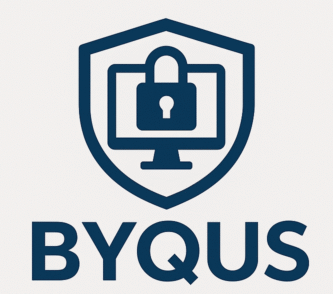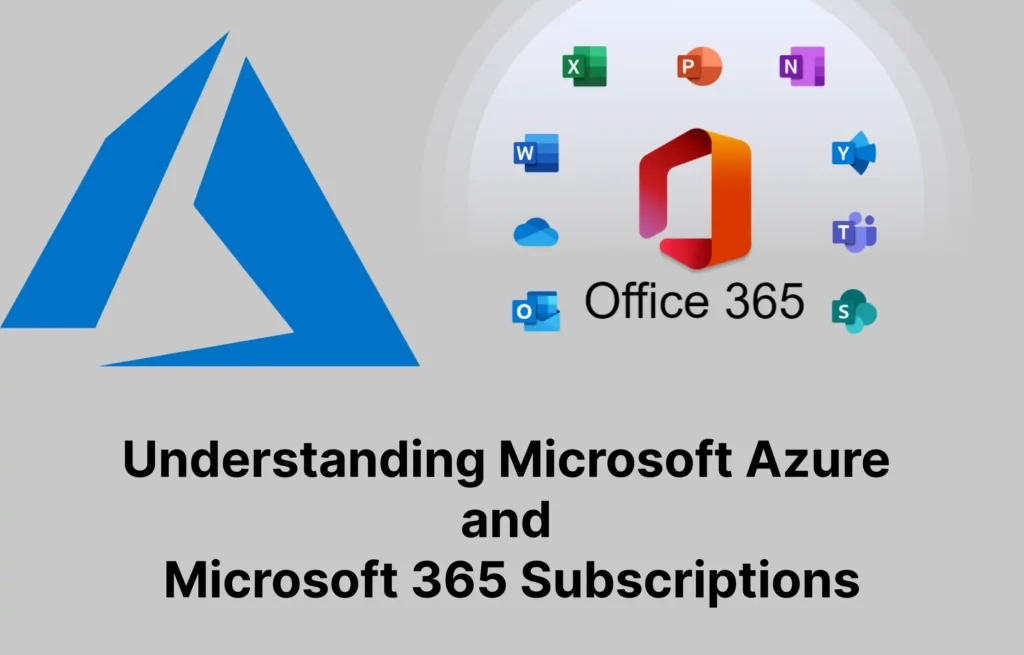Microsoft 365 is everywhere today—at work, in schools, and even in our personal lives. Yet many beginners still confuse Microsoft 365 with Office 365, Azure, Windows, or the older “MS Office” suite.
If you’re starting your learning journey or planning to adopt Microsoft 365 for your organization, this guide will give you a clear, simple, and complete understanding of the entire Microsoft 365 ecosystem. Whether you’re a student, professional, or IT administrator, this beginner-friendly guide will help you understand how Microsoft 365 works, what it includes, and why it matters.
To keep everything structured and easy to follow, this blog is divided into five major questions:
- What Is Microsoft 365? (A Beginner-Friendly Definition)
- What Apps and Services Are Included in M365?
- How Does Microsoft 365 Work? (Architecture Explained Simply)
- What Are the Different Microsoft 365 Plans? (Licensing Explained Simply)
- Why Is Microsoft 365 Important Today? (Benefits for Everyone)
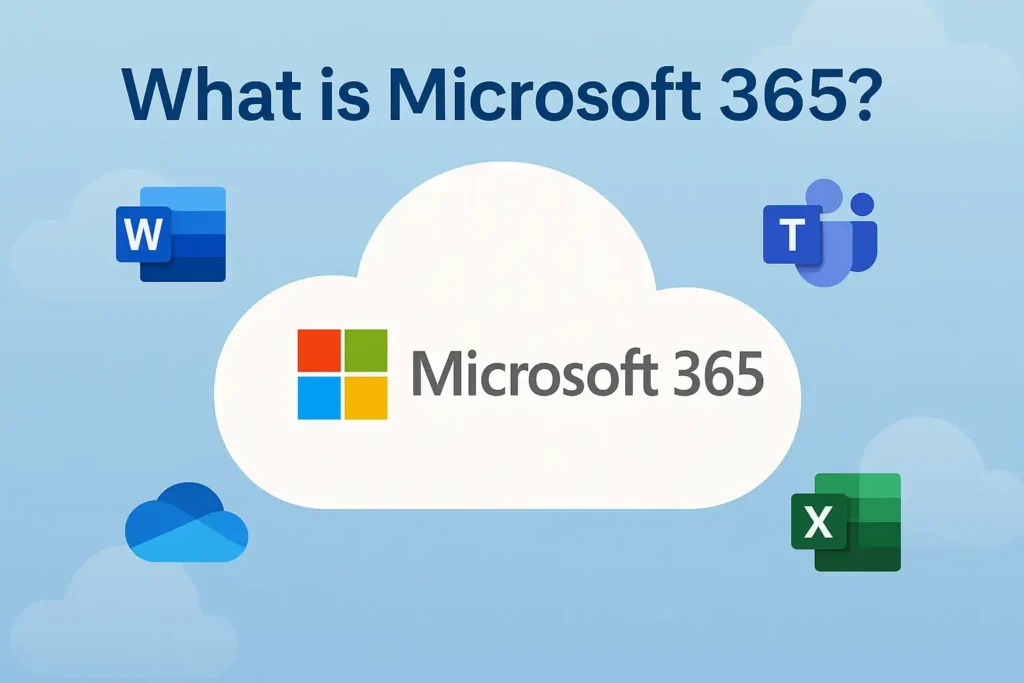
What is Microsoft 365?
1. What Is Microsoft 365? (A Beginner-Friendly Definition)
Microsoft 365 is far more than a collection of office applications—it is a complete cloud-based productivity, collaboration, security, identity, and device management ecosystem. Designed for individuals, small businesses, large enterprises, and educational institutions, it brings together everything an organization needs to work efficiently and securely in a modern, hybrid, and cloud-enabled environment.
At its core, Microsoft 365 unifies four major capabilities:
Productivity
This includes the familiar and powerful Office applications—Word, Excel, PowerPoint, Outlook, and OneNote—available on the web, desktop, and mobile. Whether creating documents, analyzing data, or preparing presentations, users can work seamlessly across devices while enjoying real-time autosave, version control, and online collaboration. These apps are deeply integrated with cloud storage, enabling fast access to work from anywhere.
Collaboration
Microsoft 365 is built for teamwork. Tools like Microsoft Teams, SharePoint Online, and OneDrive for Business make it effortless to chat, meet, share files, co-author documents, host webinars, run projects, and collaborate in real time. Teams acts as the communication hub, while SharePoint powers team sites and enterprise content management. Combined, they eliminate the need for traditional file servers and offer a structured, secure, and highly accessible way of working.
Security & Identity
Security is the foundation of Microsoft 365. Services such as Microsoft Entra ID, Multi-Factor Authentication (MFA), Conditional Access policies, Microsoft Defender for Office 365, Information Protection, and Data Loss Prevention (DLP) ensure strong identity protection and data security. Microsoft 365 continuously checks user identity, device health, session risk, and location to ensure secure access every time. These intelligent security layers help protect organizations from phishing, malware, data leaks, and unauthorized access.
Device & Endpoint Management
With the rise of remote work and BYOD environments, organizations need a centralized way to manage devices. Microsoft Intune provides Mobile Device Management (MDM) and Mobile Application Management (MAM) for Windows, macOS, iOS, and Android devices. IT teams can deploy apps, enforce security baselines, manage updates, configure compliance rules, and remotely wipe lost or compromised devices. Combined with Endpoint Security and Autopilot, Intune transforms how organizations manage and secure endpoints.
Why Microsoft 365 Is More Than “Office in the Cloud”
Many beginners assume that Microsoft 365 is simply the online version of Word or Excel. But Microsoft 365 extends far beyond that. It includes secure cloud storage (OneDrive, SharePoint), enterprise-grade email (Exchange Online), AI-powered tools (Microsoft Copilot), compliance features, identity protection, threat detection, and device management—all integrated into a single cloud platform.
This breadth of services is the primary reason businesses choose Microsoft 365 not just for productivity, but for governance, compliance, security, and modern digital workplace transformation. Whether you’re a small business, a global enterprise, or an individual user, Microsoft 365 provides a scalable and secure framework to manage work in the hybrid world.
In simple words:
Microsoft 365 = Productivity + Collaboration + Security + Identity + Device Management + AI.
It’s an ecosystem—secure, intelligent, and deeply interconnected.
Summary
- Office apps → Create work
- Teams & SharePoint → Work together
- Entra ID, MFA, Defender → Protect work
- Intune → Manage devices that access work
- Copilot → AI that assists work
👉 Everything lives in the cloud
👉 Everything is always updated
👉 Everything works together
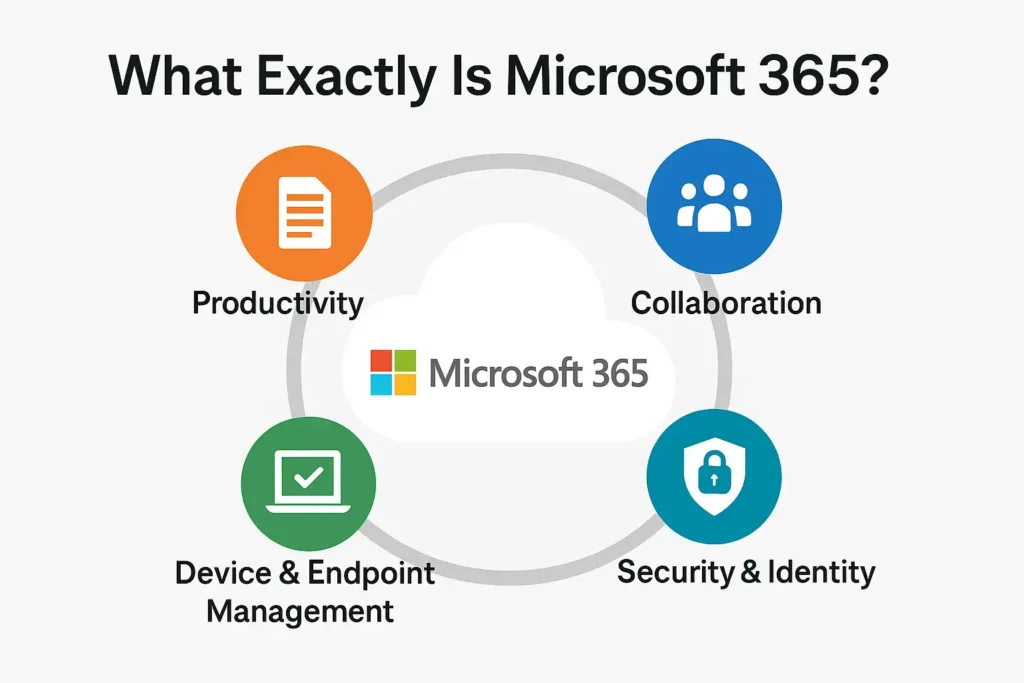
2. What Apps and Services Are Included in Microsoft 365?
Microsoft 365 is not just one application—it is a complete suite of interconnected cloud services designed to meet the needs of modern organizations. To help beginners understand its structure, we can group the apps and services into clear functional categories. Each category solves a different problem, from creating content to securing access and managing devices.
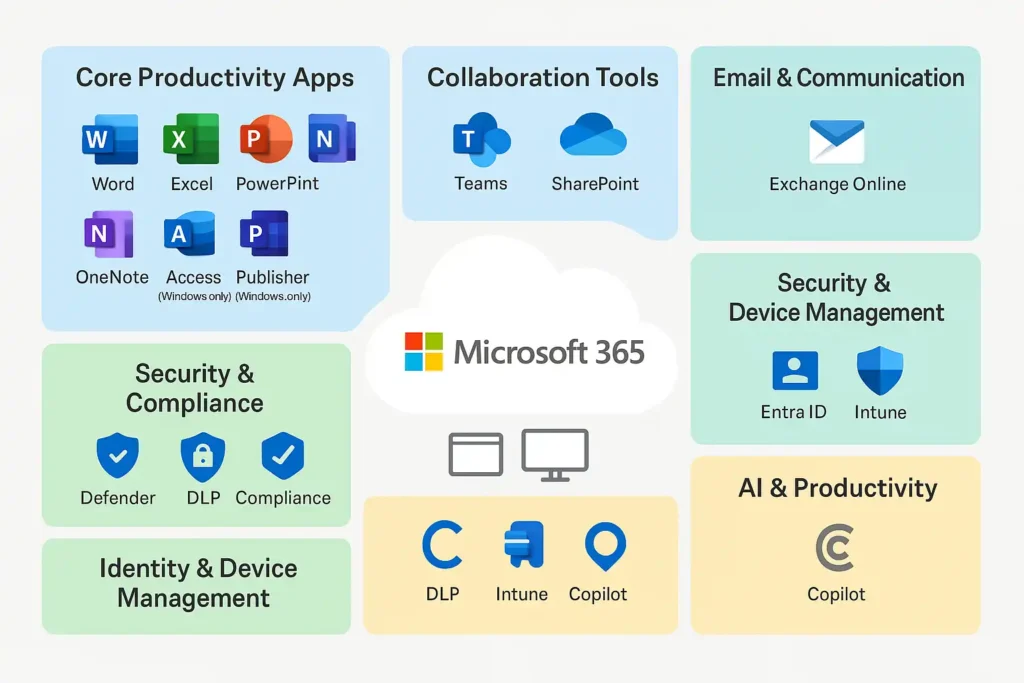
Core Productivity Apps
These are the familiar Office applications that most people use daily. Microsoft 365 provides both desktop versions and fully functional web versions, allowing users to work across any device.
- Word – Create documents, reports, letters, proposals, and academic content. Word supports real-time co-authoring, version control, and intelligent editing tools.
- Excel – The most powerful tool for data analysis, dashboards, calculations, and business reporting. Excel integrates with Power BI and supports advanced functions, pivot tables, and automation.
- PowerPoint – Create professional presentations with design ideas, animations, templates, and seamless collaboration.
- Outlook – A unified email and calendar system designed for professional communication, scheduling, and organization.
- OneNote – A digital notebook for handwritten or typed notes, screenshots, voice recordings, and class or meeting notes.
- Access (Windows only) – A desktop database application used primarily in small to mid-sized business solutions.
- Publisher (Windows only) – A tool for graphic layout and professional-looking flyers, brochures, and newsletters.
These productivity apps form the foundation of Microsoft 365, helping users create, edit, and manage work efficiently.
Each of these services can be used as a web app, a mobile app, or a desktop app—giving users flexibility to work from anywhere.
Collaboration Tools
Collaboration is the heart of Microsoft 365, and these services make teamwork seamless—whether across the office or across the globe.
Microsoft Teams
The central hub for communication and collaboration. Teams integrates chat, audio/video meetings, file sharing, channels, webinars, calling, and third-party apps. It has become the standard platform for remote and hybrid work.
SharePoint Online
A powerful platform for team sites, document libraries, intranet portals, workflow automation, and enterprise content management. SharePoint connects teams with secure access to shared files and resources.
OneDrive for Business
Each user gets personal cloud storage (1 TB or more), where files automatically sync across devices. OneDrive powers real-time collaboration, link-sharing, autosave, and backup for desktop folders.
Email & Communication
Exchange Online
Exchange Online provides enterprise-level email hosting with advanced security, shared mailboxes, distribution lists, calendars, and contact management. It supports:
- Malware and spam filtering
- Email retention policies
- Archiving
- Mail flow rules
- Calendar sharing
This is the backbone of email communication in Microsoft 365 organizations.
Security & Compliance Tools
Security is deeply integrated across Microsoft 365.
Microsoft Defender for Office 365
Protects email and collaboration tools from:
- Phishing
- Malware
- Ransomware
- Unsafe links and attachments
Data Loss Prevention (DLP)
Ensures sensitive data such as credit card numbers, personal information, or business secrets doesn’t leave the organization accidentally or intentionally.
Information Protection
Allows admins to create sensitivity labels to classify, encrypt, watermark, or restrict access to files and emails.
Compliance Manager
Helps organizations stay compliant with global regulations like GDPR, ISO, HIPAA, and others by providing assessments and recommendations.
These tools ensure organizations maintain trust, protect data, and meet regulatory requirements.
Identity & Device Management
Modern cloud services require strong identity protection and device control.
Microsoft Entra ID (Azure AD)
The identity backbone of Microsoft 365. Handles:
- User accounts
- Authentication
- Passwordless login
- MFA
- Conditional Access
- Single Sign-On
Every login, device, and application access is validated through Entra ID.
Microsoft Intune
A cloud-based Mobile Device and Application Management (MDM/MAM) solution. Intune allows IT teams to:
- Manage Windows, macOS, iOS, and Android devices
- Enforce security baselines
- Configure compliance policies
- Push applications and updates
- Wipe data from lost or compromised devices
Together, Entra ID + Intune create a Zero Trust security model.
AI & Productivity Tools
Microsoft Copilot
A next-generation AI assistant integrated into Microsoft 365 apps. Copilot helps:
- Draft documents in Word
- Analyze spreadsheets in Excel
- Generate slide designs in PowerPoint
- Summarize emails in Outlook
- Recap meetings and action items in Teams
Copilot transforms how people work by reducing repetitive tasks and boosting creativity.
Accessible Across Devices
Every major Microsoft 365 service—Word, Excel, Teams, OneDrive, Outlook, SharePoint—can be used on:
- Web browsers (Teams, Word Online, Excel Online)
- Desktop apps (Windows/Mac)
- Mobile apps (iOS/Android)
This cross-device flexibility ensures users can work from anywhere with a consistent experience.
Summary
Microsoft 365 apps are grouped into six areas:
👉 Create work
👉 Work together
👉 Communicate
👉 Stay secure
👉 Manage devices
👉 Use AI to be more productive
Everything works on web + mobile + desktop.
3. How Does Microsoft 365 Work? (Architecture Explained Simply)
Microsoft 365 may look like a collection of apps on the surface, but behind the scenes, it operates through a powerful and sophisticated cloud architecture built on Microsoft Azure. Understanding this foundation helps users, IT professionals, and beginners appreciate how identity, security, and data flow work together to deliver a seamless, secure, and modern digital workplace.
Built on Azure: The Cloud Platform Behind Microsoft 365
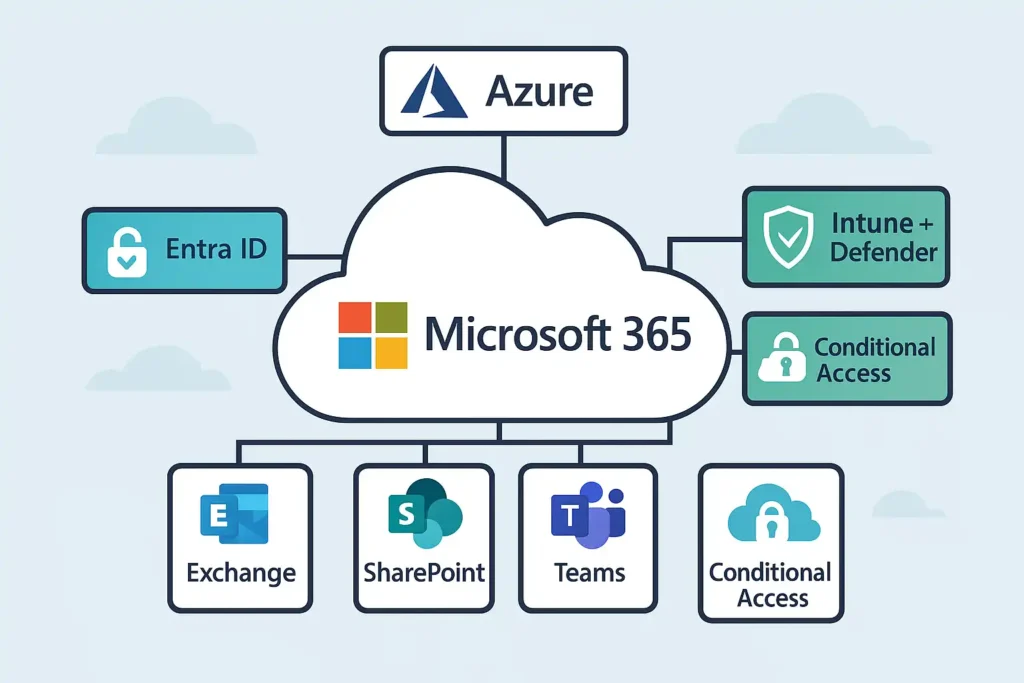
Microsoft 365 runs on Microsoft Azure, one of the world’s largest and most secure cloud platforms. Azure is responsible for providing:
- Global data centers across multiple regions
- Compute power for running apps
- Networking for fast and reliable connectivity
- Storage and backups for email, files, and metadata
- Security infrastructure including encryption, threat detection, and access control
Because it is built on Azure, Microsoft 365 enjoys high availability, automatic updates, and massive scalability—allowing millions of users to work without interruption.
Identity Is Central: Entra ID as the Brain of Microsoft 365
At the core of Microsoft 365 lies Microsoft Entra ID (formerly Azure AD), which acts as the identity control plane for every user, device, app, and session.
Entra ID manages:
- User authentication (login process)
- Multi-Factor Authentication (MFA)
- Single Sign-On (SSO) across Microsoft and third-party apps
- Conditional Access policies that evaluate risk
- Passwordless login with biometrics or Authenticator app
- Access tokens used for secure communication between apps
Every time a user logs in, opens a file, or joins a meeting, Entra ID verifies identity, checks policies, and grants access based on zero-trust principles.
Service-Specific Storage: Where Data Lives
Different Microsoft 365 services store data in different locations based on their design and purpose.
Exchange Online → Email & Calendars
Stores:
- Emails
- Calendar entries
- Contacts
- Mail rules
- Retention policies
SharePoint Online → Shared Files & Intranets
Stores:
- Team documents
- SharePoint sites
- Intranet content
- Metadata
- Lists and libraries
OneDrive for Business → Personal Files
Stores:
- User’s personal documents
- Desktop/Document/Pictures backup
- Files shared privately
Microsoft Teams → Collaboration Data
Stores:
- Chats
- Channels
- Meeting recordings
- Shared files
- Whiteboards
These storage systems work together, ensuring data is accessible, versioned, and backed up in the cloud.
Cloud-Only vs Hybrid Identity: Two Deployment Models
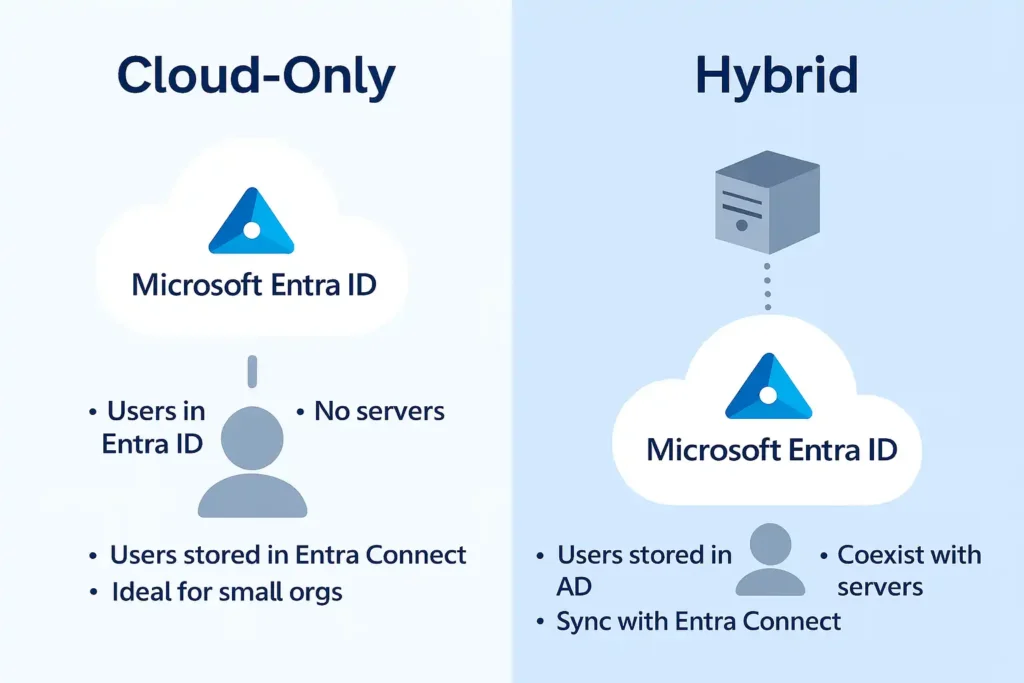
Microsoft 365 supports both modern and traditional environments depending on an organization’s needs.
1. Cloud-Only Identity
In a cloud-only setup:
- Users exist only in Entra ID
- No on-premises servers are needed
- Ideal for startups, small businesses, and cloud-first organizations
This is the simplest, fastest, and most common model today.
2. Hybrid Identity
In a hybrid setup:
- Identities are created in on-prem Active Directory
- Synced to Entra ID using Microsoft Entra Connect
- Password Hash Sync (PHS), Pass-Through Authentication (PTA), or Federation is used
Hybrid identity is used by:
- Enterprises with legacy applications
- Organizations with on-prem servers
- Businesses transitioning gradually to the cloud
This model allows local and cloud identities to co-exist seamlessly.
Multi-Layered Security: How Microsoft 365 Protects Everything
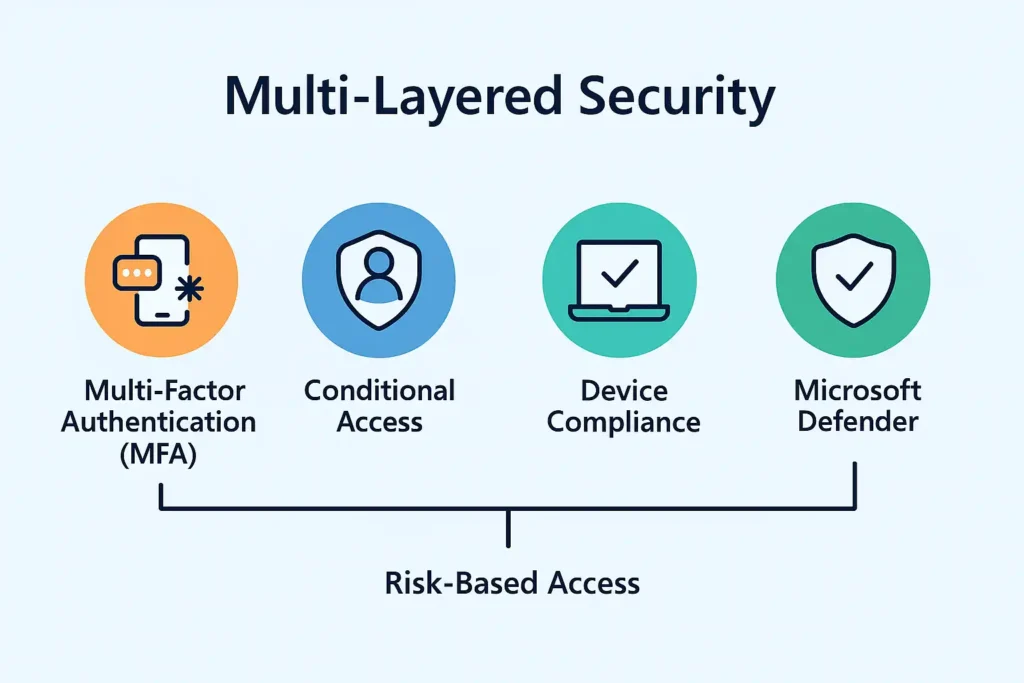
Security in Microsoft 365 is not a single feature—it is a layered system with continuous checks:
Authentication Controls
- MFA
- Passwordless sign-in
- Sign-in risk evaluation
Conditional Access
Policies decide:
- Who can access
- From which device
- From which location
- Under what conditions
Device Health
Intune ensures:
- Devices comply with security policies
- They are up to date
- Jailbroken or compromised devices are blocked
Threat Detection & Response
Defender services scan emails, files, and sessions for:
- Malware
- Phishing
- Ransomware
- Suspicious behavior
This multi-layered approach ensures that even if one layer fails, others stand to protect identity and data.
Summary
Microsoft 365 works by combining:
- Azure → Cloud infrastructure
- Entra ID → Identity
- Exchange/SharePoint/Teams → Storage + communication
- Intune + Defender → Device + threat protection
- Conditional Access → Access control
Everything is designed so users can work securely from anywhere.
4. What Are the Different Microsoft 365 Plans? (Licensing Explained Simply)
Microsoft 365 offers a wide range of plans designed for different types of users—individuals, families, small businesses, large enterprises, frontline workers, and educational institutions. Each plan includes a unique combination of apps and services, making it important to choose the right one based on productivity needs, collaboration requirements, device management, and security expectations.
To simplify the selection process, let’s break down the plans into five major categories.
1. Microsoft 365 Home Plans
Home plans are designed for personal use, families, students, and individuals who need productivity apps and cloud storage.
Microsoft 365 Personal
- For one user
- Includes Word, Excel, PowerPoint, Outlook
- 1 TB OneDrive storage
- Access across Windows, macOS, iOS, and Android
- Ideal for individual students, freelancers, or personal document management
Microsoft 365 Family
- For up to 6 users
- Includes everything in Personal, but shared
- Each user gets 1 TB storage
- Family Safety features for device/location monitoring
- Best for households and family-sharing environments
These plans focus mainly on productivity and storage, without enterprise-grade management or security controls.
2. Microsoft 365 Business Plans
Designed for small and medium-sized businesses (SMBs), business plans provide tools for communication, collaboration, and light to advanced security.
Microsoft 365 Business Basic
- Web and mobile versions of Word, Excel, PowerPoint
- Professional email via Exchange Online
- Teams for chat and meetings
- OneDrive and SharePoint
- Best for organizations needing email + cloud services, but not desktop apps
Microsoft 365 Business Standard
Includes everything in Basic, plus:
- Desktop versions of Office apps (Word, Excel, etc.)
- Advanced productivity tools like Bookings
- Better collaboration options
Perfect for companies needing full desktop apps with cloud collaboration.
Microsoft 365 Business Premium
Everything in Standard, plus:
- Microsoft Intune (device & app management)
- Advanced security features
- Conditional Access
- Defender for Office 365 (advanced threat protection)
Ideal for businesses that want enterprise-level security but remain in the SMB pricing tier.
3. Microsoft 365 Enterprise Plans
Enterprise plans (E1, E3, E5) are built for medium to large organizations that require stronger security, compliance, analytics, and governance.
Microsoft 365 E1
- Web apps only (Word Online, Excel Online, etc.)
- Teams, SharePoint, OneDrive
- Email hosting
- No desktop applications
Suitable for companies wanting cloud collaboration with web-based apps.
Microsoft 365 E3
Includes everything in E1, plus:
- Full desktop Office apps
- Advanced compliance tools
- Information Protection (sensitivity labels)
- eDiscovery features
- Basic security enhancements
This is the most commonly used enterprise plan.
Microsoft 365 E5
Everything in E3, plus:
- Microsoft Defender for Office 365
- Microsoft Defender for Identity
- Azure AD Identity Protection
- Threat analytics
- Advanced auditing
- Audio conferencing and advanced Teams capabilities
- Power BI Pro (sometimes add-on-based)
E5 delivers the highest level of security, analytics, and identity protection.
4. Microsoft 365 Education Plans
These plans are designed for schools, colleges, universities, and educational institutions.
M365 A1
- Free for education
- Web-only apps
- Basic email and collaboration
M365 A3
- Desktop apps
- Device management (Intune for Education)
- Security tools
- Better administrative control
M365 A5
- Highest level of security
- Advanced analytics and threat protection
- Identity and compliance tools
Education plans offer high-value licensing at reduced costs.
5. Microsoft 365 Frontline Worker Plans
These plans are designed for employees who don’t work at a desk full time—like retail staff, factory workers, healthcare assistants, hospitality employees, and customer-facing roles.
M365 F1
- Web-based productivity apps
- Teams communication
- Basic email (sometimes restricted based on region)
M365 F3
- Desktop apps (light version)
- Advanced Teams functionality
- More cloud storage
- Simplified device management options
Frontline plans keep communication strong without needing full enterprise functionality.
| Plan Category | Plan Name | Includes | Best For |
|---|---|---|---|
| Microsoft 365 Home | Microsoft 365 Personal |
• Word, Excel, PowerPoint, Outlook • 1 TB OneDrive • Desktop + web + mobile apps | Individuals, freelancers, students |
| Microsoft 365 Family |
• All Personal features • Up to 6 users • 1 TB each • Family Safety tools | Households & sharing families | |
| Microsoft 365 Business | Business Basic |
• Web + mobile apps • Teams + SharePoint + OneDrive • Exchange Online email | Small businesses needing email + cloud apps |
| Business Standard |
• Full desktop apps • Bookings, advanced collaboration • Everything in Basic | SMBs needing full Office desktop apps | |
| Business Premium |
• Everything in Standard • Intune (MDM/MAM) • Conditional Access • Defender for Office 365 | SMBs needing security + device management | |
| Microsoft 365 Enterprise | Microsoft 365 E1 |
• Web apps only • Teams, SharePoint, OneDrive • Email hosting | Organizations using cloud-only web apps |
| Microsoft 365 E3 |
• Full desktop apps • Compliance tools • Information Protection • Everything in E1 | Mid-large companies needing security + compliance | |
| Microsoft 365 E5 |
• All E3 features • Defender for Office 365 + Identity • Identity Protection • Threat analytics • Advanced auditing • Audio conferencing • Power BI Pro (varies by region) | Enterprises needing advanced security + analytics | |
| Microsoft 365 Education | A1 |
• Free for schools • Web-only apps • Basic email + collaboration | Schools needing basic capabilities |
| A3 |
• Desktop apps • Intune for Education • Better admin control | Schools with device management needs | |
| A5 |
• All A3 features • Advanced security + analytics • Compliance tools | Educational institutions needing full security suite | |
| Microsoft 365 Frontline | F1 |
• Web-based apps • Teams communication • Basic email | Frontline workers needing light access |
| F3 |
• Desktop apps (limited) • Advanced Teams • More storage • Simple device management | Frontline roles needing richer features |
Choosing the Right Plan: A Simple Way to Decide
- If you need personal productivity → Choose Personal/Family
- If you need email + apps for a small business → Choose Business Standard
- If you need security + device management → Choose Business Premium
- If you’re an enterprise → Choose E3 or E5
- If you’re a school → Choose A3 or A5
- If your workers are mobile/deskless → Choose F1/F3
In short:
Pick a plan based on how much security, management, and productivity you need.
Summary
Microsoft 365 plans vary by:
- Apps included
- Security level
- Management capabilities
- Target users (home, business, enterprise, education, frontline)
Choose based on your needs, not just cost.
5. Why Is Microsoft 365 Important Today? (Benefits for Everyone)
Microsoft 365 has become one of the most widely adopted cloud platforms in the world—used by individuals, small businesses, large enterprises, schools, hospitals, and government agencies. Its strength lies in how seamlessly it brings together productivity, collaboration, security, identity, and device management into one unified ecosystem. In today’s hybrid and remote work era, Microsoft 365 provides the flexibility and reliability organizations need to operate without interruption.
Below are the major reasons Microsoft 365 is essential in the modern workplace.
1. Work from Anywhere — The Modern Workplace Made Simple
The shift toward remote and hybrid work has made cloud accessibility more important than ever. M365 enables users to work from any location and any device with:
- Cloud-synced files
- Web-based Office apps
- Teams chat and meetings
- Mobile apps for Outlook, OneDrive, Word, Excel, and more
- Consistent experience across Windows, macOS, iOS, Android, and web browsers
Documents stored in OneDrive or SharePoint automatically sync across devices, ensuring users always have access to the latest version. With Teams meetings, chat, and calling, employees collaborate just as effectively from home as they do in the office.
This anywhere-access capability is one of the most transformative benefits Microsoft 365 offers.
2. Strong Security — Enterprise Protection Built In
Cyber threats have increased in scale and complexity, making robust security a must for organizations of all sizes. Microsoft 365 includes layered, intelligent security tools that protect identities, devices, apps, and data.
Key protection features include:
Multi-Factor Authentication (MFA)
Adds an extra layer of login protection to prevent unauthorized access—even if passwords are stolen.
Conditional Access
Allows IT admins to enforce access rules based on:
- User identity
- Device state
- Location
- Risk score
If a login attempt appears suspicious, the system can require MFA or block access entirely.
Data Loss Prevention (DLP)
Identifies and prevents sensitive information (credit cards, personal data, confidential documents) from leaving the organization.
Microsoft Defender
Provides advanced threat protection against:
- Phishing
- Malware
- Ransomware
- Unsafe attachments
- Malicious links
By combining these security tools under a Zero Trust model, Microsoft 365 significantly reduces security risks and ensures data stays protected.
3. Real-Time Collaboration — Work Together Seamlessly
Collaboration is at the heart of Microsoft 365. Tools like Teams, SharePoint, and OneDrive allow employees to work together efficiently, regardless of time zone or location.
Co-authoring
Multiple users can edit Word documents, Excel spreadsheets, or PowerPoint presentations at the same time with changes visible in real time.
Teams Meetings & Chat
Teams centralizes:
- Instant messaging
- Virtual meetings
- Webinars
- File sharing
- Project collaboration
Shared Libraries
SharePoint and OneDrive act as cloud-based file servers, replacing traditional on-prem file-sharing systems.
These tools remove the friction from group work, making collaboration faster, smoother, and more transparent.
4. AI Boosts Productivity — Copilot Does the Heavy Lifting
Microsoft Copilot, the AI assistant integrated throughout Microsoft 365, dramatically enhances productivity by handling common and complex tasks.
Copilot can:
- Draft documents, emails, summaries, or blogs
- Analyze large Excel datasets and create pivot tables
- Generate PowerPoint slides from text or ideas
- Summarize Teams meetings, including action items
- Create meeting agendas or project plans
- Answer context-based questions using organizational data
This allows employees to focus on strategy and creativity rather than repetitive manual work. Copilot is one of the biggest productivity breakthroughs in the Microsoft ecosystem to date.
5. Cost & Maintenance Efficiency — Lower IT Overhead
Before cloud platforms, organizations relied heavily on on-premises servers, manual updates, local backups, and frequent maintenance. Microsoft 365 eliminates much of this burden.
With M365:
- No on-prem email servers needed
- No manual software installations
- Automatic security patches
- Centralized management from a web-based admin center
- Scalable licensing (pay for what you use)
- Reduced hardware costs
- Built-in redundancy and backups
Both small businesses and large enterprises benefit from predictable costs and fewer IT complexities.
Why It Matters
Microsoft 365 empowers organizations to:
- Increase productivity
- Improve communication
- Strengthen security
- Reduce costs
- Support hybrid and remote work
- Modernize digital workflows
- Simplify IT operations
- Harness AI for better decision-making
This combination is why Microsoft 365 is widely considered a practical, future-ready platform for companies of all sizes.
Summary
Microsoft 365 is important because it:
- Lets you work from anywhere
- Keeps everything secure
- Helps teams work together
- Reduces IT costs
- Adds AI to your daily workflow
This is why businesses of all sizes depend on it.
Conclusion & Next Steps
Microsoft 365 is far more than an online version of Office—it is a complete, cloud-powered ecosystem that brings together productivity tools, collaboration platforms, identity management, device security, and enterprise-level protection. It offers a modern, flexible foundation that supports today’s hybrid work environment and empowers individuals and organizations to work smarter, faster, and more securely.
Whether you are a beginner exploring Microsoft 365 for the first time or an IT professional looking to strengthen foundational knowledge, the journey starts with understanding how the various pieces work together—Word and Excel for productivity, Teams and SharePoint for collaboration, Entra ID for identity, Intune for device management, and Defender for security.
To begin your learning path, here are the most practical next steps:
1. Explore a Microsoft 365 Trial
Hands-on experience is the best way to understand the platform. A trial gives you access to key apps like Outlook, Teams, OneDrive, and the Microsoft 365 Admin Center.
2. Learn the Basics of Microsoft Entra ID (Azure AD)
Identity is the foundation of Microsoft 365. Start by understanding user accounts, authentication, MFA, and how access is granted to apps and services.
3. Try OneDrive and SharePoint for File Storage
Upload files, share them with others, and observe version control, permissions, and real-time co-authoring in action. This will help you understand how cloud storage replaces traditional file servers.
4. Host or Join a Demo Teams Meeting
Experiment with chat, video calls, file sharing, screen sharing, and meeting recording. Teams is the collaboration engine of Microsoft 365.
Once you’re comfortable with the basics, you can move further into structured learning. If you’re ready to continue this series, the next recommended posts are:
- User Accounts in Microsoft Entra ID (Understanding identity at the user level)
- Groups in Microsoft Entra ID (Managing access and permissions through groups)
Replace these placeholders with the actual URLs once your posts are published.
These topics will help you build a strong foundation before moving into advanced areas like conditional access, device management with Intune, and security configurations. By progressing step-by-step, you’ll gain a clear, practical understanding of how Microsoft 365 functions as a unified cloud platform.
How Can Byqus Help in Learning Microsoft 365?
Learning Microsoft 365 becomes far more effective when theory is supported with real, hands-on demonstrations. That’s where Byqus Learning steps in. If you want to understand Microsoft 365 concepts clearly, see real configurations, or watch step-by-step tutorials in action, the Byqus Learning YouTube channel (@byqus_learning) is your perfect companion.
Hands-On, Practical Demonstrations
The channel provides easy-to-follow, practical demonstration videos that show:
- How to configure features inside the M365 Admin Center
- Step-by-step identity management tasks in Microsoft Entra ID
- Intune device management and policy configuration
- Security setup, Conditional Access, and MFA configuration
- SharePoint and OneDrive file management
- Teams setup, meetings, and collaboration workflows
Each video follows a real-world approach, helping learners understand not just what to do, but why each step matters.
@Byqus
Hands-on Microsoft 365 tutorials, Entra ID walkthroughs, Intune demos and practical cloud admin guides. Watch step-by-step videos to learn by doing.
FAQs About M365
1. What is M365 in simple terms?
Microsoft 365 is a cloud-based platform that includes Office apps (Word, Excel, PowerPoint), collaboration tools (Teams, SharePoint, OneDrive), identity and access management (Entra ID), device management (Intune), and advanced security tools like Microsoft Defender.
2. How is M365 different from Office 365?
Office 365 focused mainly on productivity apps and email. Microsoft 365 includes everything in Office 365 plus identity, device management, security, compliance, and cloud-based management capabilities.
3. Do I need on-prem servers to use M365?
No. Microsoft 365 can be used as cloud-only. However, larger organizations may run a hybrid environment where on-prem Active Directory syncs with Entra ID via Entra Connect.
4. Can I use M365 on multiple devices?
Yes. You can use Microsoft 365 apps on Windows, macOS, iOS, Android, and web browsers. Your files sync across devices using OneDrive and SharePoint.
5. Which M365 plan is best for small businesses?
For most small businesses, Microsoft 365 Business Standard or Business Premium is ideal. Business Premium includes Intune, Conditional Access, and Defender for Office 365 for added security.
6. What security features does M365 include?
Microsoft 365 includes MFA, Conditional Access, Defender for Office 365, Information Protection, DLP, and Zero Trust identity controls via Entra ID. Together, they protect users, devices, apps, and data.
7. What is the role of Microsoft Entra ID in M365?
Entra ID (Azure AD) is the identity backbone of Microsoft 365. It manages authentication, MFA, SSO, Conditional Access, risk evaluation, and access permissions for all apps and services.
8. What is Microsoft Copilot in M365?
Microsoft Copilot is an AI assistant integrated into Word, Excel, PowerPoint, Outlook, Teams, and SharePoint. It drafts content, analyzes data, creates presentations, summarizes emails, and automates routine tasks.
9. Can I switch plans later if my organization grows?
Yes. Microsoft 365 subscriptions are flexible. You can upgrade or switch plans at any time (e.g., from Business Standard to E3 or E5) depending on your needs.
10. Do students and schools get M365 for free?
Schools often get Microsoft 365 A1 for free. Students can sign up with their school email to access apps like Word, Excel, PowerPoint, Outlook, and Teams.

